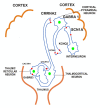Classifying epilepsy pragmatically: Past, present, and future
- PMID: 34174531
- PMCID: PMC7613525
- DOI: 10.1016/j.jns.2021.117515
Classifying epilepsy pragmatically: Past, present, and future
Abstract
The classification of epilepsy is essential for people with epilepsy and their families, healthcare providers, physicians and researchers. The International League Against Epilepsy proposed updated seizure and epilepsy classifications in 2017, while another four-dimensional epilepsy classification was updated in 2019. An Integrated Epilepsy Classification system was proposed in 2020. Existing classifications, however, lack consideration of important pragmatic factors relevant to the day-to-day life of people with epilepsy and stakeholders. Despite promising developments, consideration of comorbidities in brain development, genetic causes, and environmental triggers of epilepsy remains largely user-dependent in existing classifications. Demographics of epilepsy have changed over time, while existing classification schemes exhibit caveats. A pragmatic classification scheme should incorporate these factors to provide a nuanced classification. Validation across disparate contexts will ensure widespread applicability and ease of use. A team-based approach may simplify communication between healthcare personnel, while an individual-centred perspective may empower people with epilepsy. Together, incorporating these elements into a modern but pragmatic classification scheme may ensure optimal care for people with epilepsy by emphasising cohesiveness among its myriad users. Technological advancements such as 7T MRI, next-generation sequencing, and artificial intelligence may affect future classification efforts.
Keywords: 2017 ILAE classification; Epilepsy; Four-dimensional epilepsy classification; Integrated epilepsy classification.
Copyright © 2021. Published by Elsevier B.V.
Conflict of interest statement
NAS and CRN having no disclosure to make. GS reports personal fees from Sanofi India and the Department of Biotechnology outside the submitted work. JWS reports personal fees from Eisai, UCB Pharma, Arvelle and Zogenix Pharma; and grants from Eisai, UCB Pharma, National Epilepsy Funds (Netherlands), National Institute for Health Research and GW Pharma, outside the submitted work.
Figures
References
-
- Engel J., Jr ILAE classification of epilepsy syndromes. Epilepsy Res. 2006;70:5–10. - PubMed
-
- Falco-Walter JJ, Scheffer IE, Fisher RS. The new definition and classification of seizures and epilepsy. Epilepsy Res. 2018;139:73–79. - PubMed
-
- Caveness W, Lorentz Hjm Am, Radermecker J. A proposed international classification of epileptic seizures. Epilepsia. 1964;5:297–306. - PubMed
-
- Gastaut H. Clinical and electroencephalographical classification of epileptic seizures. Epilepsia. 1970;11:102–112. - PubMed
Publication types
MeSH terms
Grants and funding
LinkOut - more resources
Full Text Sources
Medical
Miscellaneous



